Intel Alder Lake-H Core i9-12900HK Review: MSI's Raider GE76 Goes Hybrid
by Brett Howse on January 25, 2022 9:00 AM EST- Posted in
- CPUs
- Intel
- MSI
- Laptops
- Alder Lake
- GE76 Raider
- 12th Gen Core
- Alder Lake-H
Battery Life
Built on what Intel now calls Intel 7, the new Alder Lake processors do not get a completely new foundry node to reduce power consumption. The idea of having P-Cores and E-Cores though is an interesting one for the laptop space, as in theory the E-Cores could lower power consumption quite a bit. However, that discussion will need to likely wait for the thin and light notebooks to arrive with U-Series and P-Series processors as a H-Series device with a massive RTX 3080L Ti GPU, DDR5-4800, multiple PCIe 4.0 SSDs, and a 360 Hz display are not going to be a showcase for power efficiency of a processor.
As always, our battery life tests have the display set to 200 nits brightness and the system set in its most efficient mode.
Web Battery
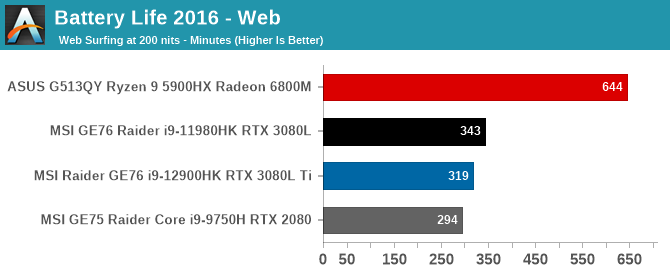
Our first test shows that the Raider GE76, despite a 99.9 Wh battery, performs very poorly if used as a portable computer. Thankfully it is not really intended to be used this way, as it is big and heavy to carry around, but the regression over the outgoing Tiger Lake model is clear. What is also very clear is how much better AMD is able to power-gate its large discrete GPU compared to NVIDIA, as the AMD gaming system dominates in the battery life tests.
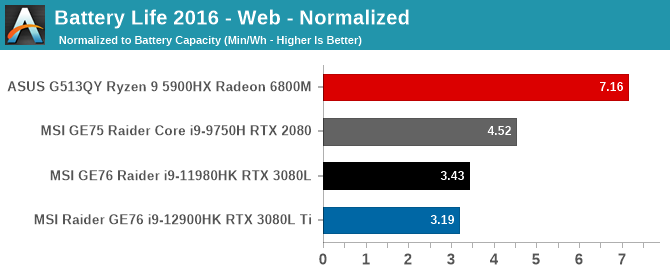
The normalized results remove the battery size from the equation and drops the new Raider GE76 to the bottom of the results. There are several variables, so it is difficult to pinpoint exactly what is causing the power consumption regression, but likely DDR5-4800 is a part of it.
PCMark Modern Office Battery
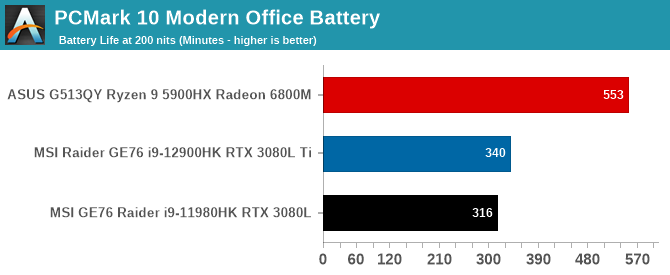
The PCMark test will run a series of workloads in a ten-minute window, and if a device finishes the work quicker, it is able to idle for a larger percentage of the ten minutes, which probably assists the new Alder Lake system here as it is overall a more performant device compared to the outgoing Tiger Lake laptop.
Movie Playback
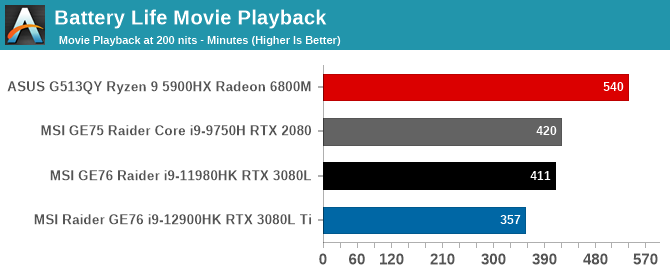
The battery life regression is even more pronounced in the battery life playback time. Clearly there is a significant amount of passive power draw in this system.
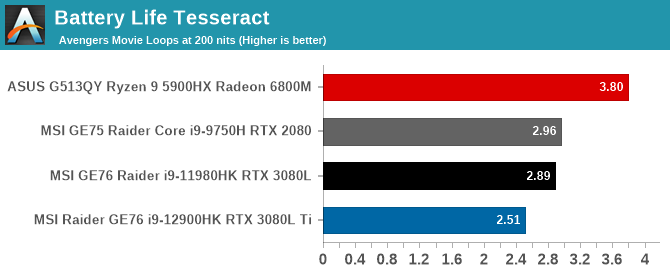
Looking at the Tesseract score, which divide the movie playback time by the length of the movie The Avengers shows that you would run out of juice halfway through your third viewing.
Battery Life Summary
In a word the battery life could be summed up as "unimpressive". The Raider GE76 is not an ideal test bed to determine CPU efficiency under load since the underlying power draw is significant. To see how Alder Lake compares we will have to wait for more power efficient platforms to get more meaningful results.
Storage Performance
Unlike with the desktop counterpart for Alder Lake, the laptop variants are limited to “just” PCIe 4.0 storage. The Raider GE76 offers support for two of them, and the system shipped with two Samsung PM9A1 PCIe 4.0 drives at 1 TB each.


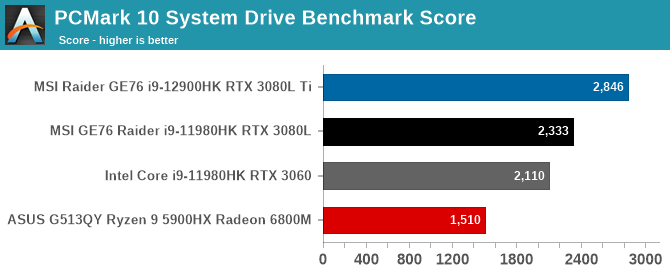
The drive performance is class leading, with the highest results we have ever achieved in the PCMark Full System Drive test.










153 Comments
View All Comments
tkSteveFOX - Wednesday, January 26, 2022 - link
Just a note for Brett here, when you do a laptop review thermals, throttling and noise levels are important things to have in the review.Brett Howse - Wednesday, January 26, 2022 - link
This isn't a laptop review. Please check the link to the GE 76 Raider review we did in September.TheinsanegamerN - Friday, January 28, 2022 - link
*reviews laptop CPU**uses laptop*
*this is not a laptop review*
Whew, anandtech quality ladies and gentlemen! I guess that throttling and thermals are not important in CPU tests either? Or would that get in the way of using RAM to exuse the hideous power draw?
corinthos - Wednesday, January 26, 2022 - link
Whole point of a laptop is portability and using unplugged for a considerable amount of the time. That's why you pay a premium. If the best Intel can do is 3.x hours on battery, this is essentially a desktop alternative/replacement, in which case you get even more for your money just buying a desktop.Brett Howse - Wednesday, January 26, 2022 - link
This is literally a desktop replacement. That's actually a product category for notebooks.Spunjji - Thursday, January 27, 2022 - link
I'm sorry you have to keep replying to comments like this...Spunjji - Thursday, January 27, 2022 - link
For me, those "percentage of no load performance" graphs may have been the most interesting. It certainly shows what Alder Lake can offer when it's being used to the fullest. It doesn't represent a use-case that I'd ever put a laptop to, but it will be very interesting for the sort of user for whom 20 threads in a mobile CPU is less a flashy selling point and more a necessity.Otherwise it's looking as I expected - peak performance is significantly better than the ageing Cezanne platform, sustained performance in a slightly more representative platform remains to be seen. Tiger Lake H was ~25% down on Cezanne in terms of performance/watt in multithreaded loads, so there's certainly potential here for Intel to have caught up and maybe even surpassed that.
abufrejoval - Thursday, January 27, 2022 - link
The least impressive statement in this review is this “Perhaps the most impressive result though is Intel’s Thread Director, which provides very impressive system responsiveness even when the system is at 100% CPU load…”, because to me it sounds either like paid content or lack of reflection.Intel is pushing E-cores as a “must have”, because it’s exclusive to their platform, very much like MMX or AVX-512 back then.
But it’s mostly yet another marketing smoke bomb.
I am convinced you could achieve a very similar gain in responsiveness by emulating the 8 E-cores via the 2 P-cores they replace in terms of silicon real-estate on Alder Lake. What you perceive as a hardware benefit is mostly an OS defect in workload management.
What happens here is that long running batch and latency sensitive interactive workloads are being separated and assigned to hardware partitioned processing pools dependent on whether they are running in the “foreground” or “background”. Doing that in the Windows task manager today, is obviously cumbersome, but writing a tool that prohibits the usage of all CPU cores once workloads are switched to background, should be trivial enough. And to my knowledge even cache partitioning has been part of x86 since Broadwell to ensure that busy background batch tasks won’t flush latency sensitive interactive workloads entirely from them.
Yes, E-cores have been proven to squeeze longer run times out of smartphones or more concurrent session support per Watt in certain cloud servers, because they are designed to be more efficient in in terms of instructions per Watt/h at the price of instructions per unit of time.
But those constraints do not apply to a gaming laptop or most desktop computers. Actually, even on ultra-thin laptops CPU core power consumption is becoming a rather insignificant contributor to overall energy spend, outside of some synthetic fringe cases.
Intel fits 8 E-cores into a similar space for 2 P-cores, so the high-end mobile Alder-Lake parts could just be 8 P cores or 32 E cores or any of the other permutations. And quite obviously you would be able to find workloads with an ideal fit for each, just as you’d also find workloads that violate either performance or efficiency targets on them.
Intel promotes a hardware partitioned compromise between E- and P-cores and then interestingly charges an E-core premium on desktop parts, where collective energy savings on remotely managed always-on volume parts might actually provide an ecological benefit. But I can’t help thinking, that a software solution via “E-core emulation” would deliver more flexibility and adjustable performance on most laptops and workstations and prefer 8P+0E over 6P+4E practically everywhere except server parts.
Bik - Thursday, January 27, 2022 - link
Simple thought will prove this correct: a big task that feels like it bogs down the whole system, will no longer be so if you willing to sacrify some cores for background tasks. The scheduler just isnt smart enough to do that today.There's another thing I notice. When it is true that 8-E cores put up more performance than 2-P cores, Intel claims of silicon real-estate between the two being equal may not be correct. Because if they do, we'll surely have all E-cores cpu for heavy multi-thread work loads. But that didnt, and I doubt, will ever happen.
diediealldie - Thursday, January 27, 2022 - link
oh, they will. There's Sierra Forest AP which consists of 128 e-cores. Intel is not making all e-cores yet since launched platforms are kind of mass-market general-purpose ones which need high ST performance along with good MT performance.